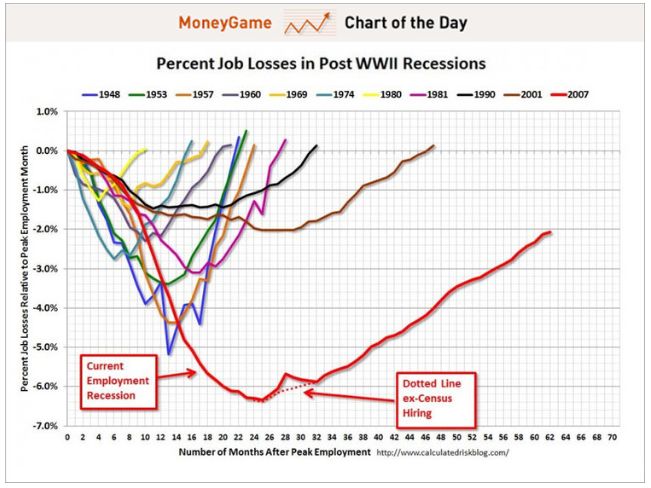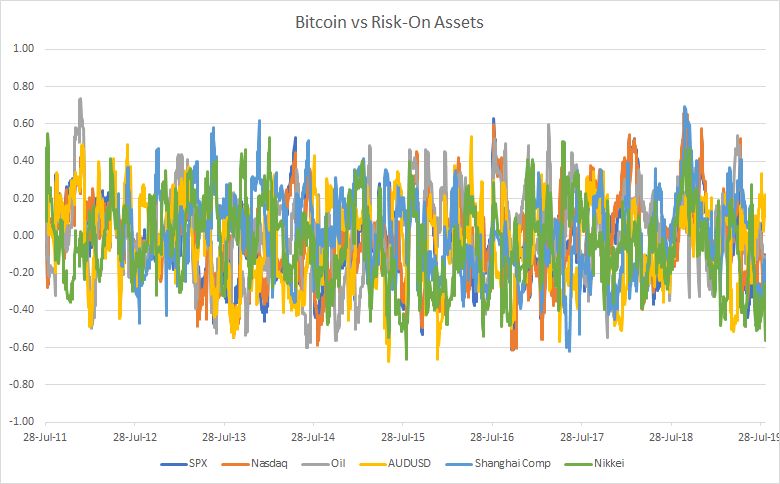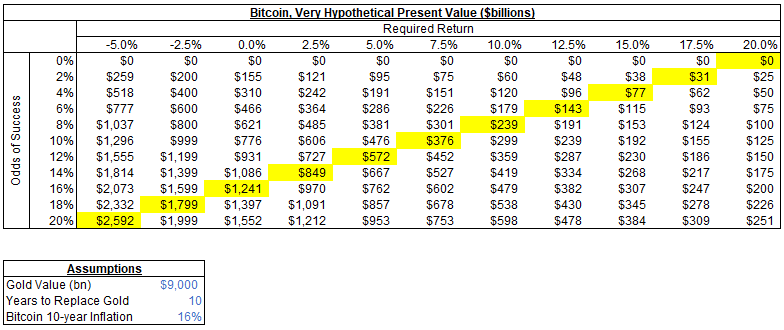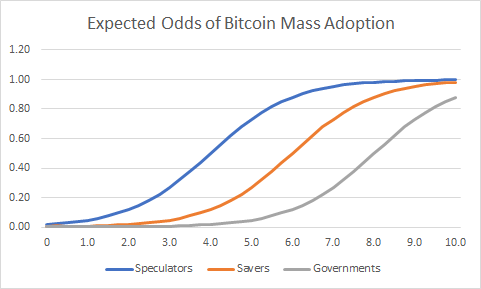Bitcoin investment from an asset allocation perspective: is Bitcoin speculative or a safe-haven asset?
Source: PayPal
Editor's Note: The original title was "Viewing Bitcoin Investment from an Asset Allocation Perspective"
This article is an article published by crypto analyst and economist Byrne Hobart on medium. From the perspective of traditional traders, this article analyzes the following six aspects: the risk and reliability of investing in Bitcoin, how to value Bitcoin and its probability of becoming a currency, how to match Bitcoin and investment portfolios, Why is it difficult to determine whether Bitcoin is a speculative product or a safe-haven asset, the comparison of Bitcoin and other risks, and the future direction of Bitcoin.
Recently, my friends kept asking me why I do n’t invest in crypto assets. I'm actually interested in Bitcoin and worked in this industry for a while, but I'm not sure what I want to do as a full-time crypto investor. Currency may be an entry point, so unless you think that Bitcoin will collapse, the correct transaction for a cryptocurrency fund is long Bitcoin. At this time, the transaction manager needs to answer two questions:
- Technical Guide | A Brief Study of Cross-chain Communication
- European authorities look at national digital currencies: love and fear
- Barbarians at the Door of the Blockchain: Understanding the Crypto Industry M & A
1. How to hold?
2. How long does it hold?
I have bitcoin in my personal account and think it is a very speculative choice. It is also a special asset. For a typical asset allocator, the correct cryptocurrency allocation is close to zero, but non-zero.
Asset allocators must fit every position into their portfolio-consider risk / reward and associations with other asset classes.
1Bitcoin risk and reliability
Bitcoin is a store of value.
There are many theories about money, but the most comprehensive thing is that money is a Schelling point: the reason you treat money as money is because others also see it as money. Schelling point is the tendency of people in game theory to choose without communication.
In most history, precious metals were the ideal Schelling point of money. Both gold and silver are difficult to find in large quantities, but when we started to find these metals, we found a good way to measure their quality. The good thing about precious metals is that everyone knows they have value, but no one has the ability to make more. The problem is that if wealth grows faster than the money supply, you will face deflation, that is, you cannot mint coins fast enough to reflect the abundance of available goods and services, and borrowers are at a disadvantage.
If you are concerned about market overruns, traditional hedging is vaults and gold. As a hedge against deflation, U.S. Treasury bonds outperformed the broad market. When the inflation rate was low, U.S. Treasury bills were inversely proportional to stocks. During periods of high inflation (because it is difficult to make more gold) and during periods of deflation (because the benefits of other assets are crushed and the opportunity cost of owning gold is low), gold outperforms the market.
In the short term, Bitcoin will fit into the framework of gold. Its supply is limited by design; it does not generate returns, so its opportunity cost is lower at lower interest rates, but if inflation increases, the lack of additional supply will lead it to outperform.
Judging by your history of buying safe-haven assets, you will see gold as the safest haven. If you buy a theoretical book that discusses "why gold is a safe-haven asset," you'll realize that Bitcoin is more risky, but more reliable. Bitcoin may be confiscated because of regulatory risks, but Bitcoin took this risk into account when it was created.
If you think bitcoin has the potential to become a safe-haven asset, you must accept the fact that it will also become a major currency. The disadvantage of Bitcoin over gold is that gold is more valuable and stable. If the value of bitcoin rises, then the value problem is solved; if the rise of value is because asset distributors and central banks are increasingly holding bitcoin, then it will become more stable.
2 Bitcoin valuation and comparison
Bitcoin has a lot of stories, and we only need to focus on its success story without having to compare it with other cryptocurrencies and unprofitable technology transactions. Bitcoin's comparison target should be gold and the US dollar. This may sound like a crazy opinion, but in reality Bitcoin's value is approximately equal to (Gold + USD) * (the probability that Bitcoin will become the default global savings instrument) . The second term in the equation is a small and unstable number, but we are ultimately adjusting the valuation based on it.
The world's current gold reserves are about 190,000 metric tons at $ 1,470 per ounce, and the value of gold is about $ 9 trillion. You can use the Swiss franc or the U.S. dollar as the other benchmark-from a perspective, the Swiss franc is more comparable, because more people hold it purely, so their assets rise when everything else falls. From another perspective, the US dollar is more comparable because any transaction we make is ultimately settled in US dollars.
But when it comes to the transfer of gold, the comparison becomes more complicated. Because we now rarely borrow money in gold (although it was common in the past; when JPMorgan Chase acquired Carnegie Steel, he paid in gold bonds; France issued Giscard bonds; Turkey also issued some bonds) . For the central bank, holding dollars is useful to deal with government or corporate borrower shortages. So it can be said that the US dollar is a hedging method to deal with specific problems. Gold is a hedge against unknown problems.
If it is normal for companies and countries to lend bitcoin, then bitcoin will be equivalent to the US dollar. But this is just what speculators are doing at this stage, so it is not worth considering. There will be a small possibility that gold-based lending will then make the situation completely different, and it is not worth guessing about it today.
Therefore, therefore, it makes sense for gold to be an asset that is similar to Bitcoin (with few intrinsic uses, scarce, and relatively easy to transfer), and can also be used for Bitcoin purposes (hedging extreme changes in asset prices).
In this framework, valuing Bitcoin is simple. Not easy, but simple: if you have the required rate of return, the date you expect Bitcoin to replace gold, and you have an estimate of how likely this is to happen, you can easily extrapolate the value that appears. For example, if you think that Bitcoin has a 1% chance of replacing gold in ten years, its expected future value in 2029 is $ 90 billion. If you want Bitcoin to have the same historical Sharpe ratio as stocks, and you want stocks to provide a return of 3% above the risk-free rate (below the historical average, but we need to be careful here). Compared with S & P's 10% volatility, Bitcoin's annual volatility is 50%, so the annual return of Bitcoin needs to reach about 18%.
Assume that the discount rate is 18%, the term is ten years, and 90bn is the future value, so the current fair value is the fair value of 17bn. But this result does not take inflation into account. Bitcoin's inflation is fixed, but not zero. Over the next decade, the outstanding bitcoin supply will grow by about 16%, so this number has shrunk to $ 15bn. The target price of $ 15bn is mismatched relative to Bitcoin's current market value of $ 1,570bn.
But don't despair!
We can use the following three main levers:
1. Perhaps the probability of Bitcoin replacing gold is greater than 1%.
2. Perhaps our expected return is too high. The expected return of 18% is based on the assumption that Bitcoin will remain as volatile as it is in the next ten years, but highly volatile assets are not compatible with reserve assets. If Bitcoin becomes more of a reserve asset, there will be more buyers and price changes will be more difficult.
3. We will set a minimum bid based on the stock price, but in the long run, Bitcoin will not become the same as the stock. It will be more like a gold option.
This allows us to make more kinds of assumptions. Assume that the probability of Bitcoin replacing gold is 5%, not 1%, and we split the difference in the required rate of return-8% higher than the risk-free rate, not 16%. This will give us a target of 170bn, which is slightly higher than today's valuation. In this way, the estimation of replacement odds is complete, and long-term Bitcoin investments require investors to constantly re-evaluate these odds.
3How Bitcoin Matches Your Portfolio
There is an old saying-the market has climbed the "wall of anxiety", which means that when everyone is afraid of bad things, stockholders can't get benefits every day.
Bitcoin is different: it keeps going up and down the "wall". No one really knows what happened, everyone is selling something. People tried to value it, but the result was either zero or infinity. Bitcoin is either a Ponzi scheme, a Dunning-Kruggerand, a pure speculative instrument that doesn't even have a golden luster–or gold, it's just easier to hide and easier to trade, so it's more valuable.
Contradictions exist even in bull markets. Some people talk about the process of bitcoin development and provide elegant solutions to the long-standing CS problem, Satoshi Nakamoto and the core developers. Others refer to it as a highly volatile store of value, and you buy it when you think that the price of all other assets, except the money supply, is falling.
So, is this part of superhuman stock, or the Swiss franc? There is a difference between them.
Specifically, in the context of investment portfolios, there is a difference as a super-optimistic technical means or a pessimistic emergency asset. If you hold too much risk, which bitcoin position can offset this risk-long or short?
Let's take a look.
4 reasons why it's difficult to determine if Bitcoin is risky or hedged
First, let's take a step back: what does hedging risk and risk appetite mean? After the financial crisis, I started to hear the word often. If you look at the S & P's ten-year chart, you will see a stable development process with some fluctuations, but in the first years after the crisis, each fluctuation is enough to make people tremble.
The aftermath of the crisis continues-the unemployment rate remains high, but the rate of recovery is at an all-time low:

Source: Business Insider, The Scariest Jobs Chart Ever
We have also been affected by ongoing balance sheets, especially in Europe. "Black Swan" insurance is painfully expensive. As Mike Green said in a recent interview:
This is a high-risk world. In a globalized world where financial capital and trade connect economies, it's hard to say when the S & P 500 fell, it didn't affect the economies of every country that exported to the United States, and everyone in that economy.
Therefore, in the post-crisis period, the only important question is: Does this bottom out? If we fall to the lowest point, we can buy anything that is good for the global economic recovery: cheap emerging market stocks, high-yield bonds, Australian dollars, copper, oil. It makes sense to sell any high-risk hedge assets, such as government bonds, yen, dollars, Swiss francs, or gold.
This is somewhat ironic because "risky" trade assumes that the world has recoupled, and that crisis is an accident in this long-term trend. During the boom, when rich countries' valuations were too high, investors set their sights on riskier venues and asset classes. When the results are not good, they will return to what they know and reinvest; German banks bought a large number of CDOs in the middle of the first decade of the 21st century, then learned lessons, re-purchased German government bonds, and made small and medium Business lending.
In a world of healthy competition and adventure, disputes are mediated through the market. China competes with Europe and the United States for raw materials through bidding. Risk aversion measures often involve higher price correlations so that the owner of leveraged assets must sell all products immediately. But in a truly adventurous world, the potential relevance also changes: Japan is an ally of the United States, while Switzerland is basically a giant mountain city with a high rate of gun ownership. But as the US unemployment rate fell, the yen and Swiss franc both rose 1%.
Risk assets are all the same, but the nature of hedge assets is different because their unique properties depend on their characteristics. There are two types of assets:
1. Assets that change to accommodate a wide range of risk appetites. Because leveraged investors either borrow or short: USD, JPY, Treasury (if you have high risk debt and want to hedge interest rate risk, you will short them directly or indirectly).
2. These assets perform better in specific disaster situations, such as financial crises, major wars, epidemics, major trade disruptions, or oil crises. Crucially, the backtesting of these assets ignored important allocations. If the fiat currency collapses, something like gold or bitcoin will be very valuable (though if the collapse severely disrupts the Internet, the value of bitcoin will also shrink dramatically). Ten years ago, a recession triggered by oil shortages would make the U.S. dollar an extreme risky asset because the U.S. was a major importer of oil a decade ago; today, it will become a safe-haven asset. Assets, because the United States does not rely on oil, its economy is relatively diversified, and it has a large number of sources of internal demand. China may have made a similar change: Ten years ago, a global crisis would be an opportunity for them to expand their sphere of influence and make concessions to neighboring countries; today, China is highly leveraged, its population structure is risky, and it is highly dependent on trade.
If you run a simple optimization algorithm based on historical returns and the volatility of your portfolio, the algorithm will tend to use extremely high-risk assets and very low-risk assets as portfolios, while allocating funds for other assets Rarely. In practice, the portfolio manager separates the high-risk and low-risk categories, but ends up following essentially the same design. In economies with globalized commodity and capital flows, such a portfolio will have different results during periods of economic prosperity and economic downturn.
In this model, Bitcoin must meet one of these conditions. It has the volatility and technology of risk guarantee, but it is purely risk prevention in the long run. Based on experience, where will it ultimately be?
5 Bitcoin vs. other risky assets
To more accurately classify Bitcoin as a risky asset or a safe-haven asset, I compared it to a handful of other assets. In a basket of risky assets, the main indexes include (S & P 500, Nasdaq 100, Shanghai Composite Index, Nikkei) and other assets (Australian dollar, US dollar, oil) that track macroeconomic performance.
When we tracked the 30-day rolling correlation of Bitcoin with risky assets, we didn't find anything …

In the hedge asset analogy, we used the same approach.

The correlation is also zero.
There are several perspectives on this issue:
1.The price of Bitcoin is completely random and has nothing to do with hedging; this is pure gambling.
2.Bitcoin's return is driven by factors that do not directly affect other tools, such as the need for money laundering. Not long ago, I looked at other money laundering methods and tested them, but I didn't find anything meaningful-the price of Bitcoin has nothing to do with Macau gaming revenue or Vancouver house prices.
3.Bitcoin is not related to transactions with high-risk or hedging assets, because it reflects the nature of both. In this model, it should trade like a small mining company: a highly variable bet whose returns are exceptionally stable assets.
The first option is not compatible with the bitcoin contained in the portfolio. This is a good null hypothesis; if Bitcoin is a gambling asset, it will eventually become zero. However, for those who operate a diversified portfolio, two other options make Bitcoin a very interesting thing to hold: As long as you are optimistic about the ultimate return of Bitcoin, it has a low correlation with other assets Sex means that it is a very powerful and diversified investment vehicle.
6 Future directions for Bitcoin
The development direction of Bitcoin is this: When asset distributors think it is a safe asset, they will buy a small amount of Bitcoin. This has three effects: it significantly increases the price; it reduces volatility because asset allocators have rebalanced their holdings, which means they are shorting the market; this makes Bitcoin more likely to be a safe assets.
This happened to Shering Point again. If every major asset allocator believes that 0.1% is the ideal weight of Bitcoin, then the ideal weight must be higher than 0.1%, so they will gradually increase and continue until they reach equilibrium. As the probability of Bitcoin being accepted as a reserve asset increases, so does its volatility.
You can draw a hypothetical valuation of Bitcoin like this:

I showed a lot of possibilities, but I emphasized the only reasonable way: as the probability of Bitcoin replacing gold rises, the required rate of return decreases.
Of course, as the value of Bitcoin rises, so does the regulatory risk. Most governments like to have monetary sovereignty. If they want to change it, it's because they want more. Therefore, the higher the price of Bitcoin, the greater the government's concerns may be.
When the government banned it, it was because they had realized it was a problem, but it was an unregulated network and it was growing much faster than the government. If they banned Bitcoin because it was used for drugs and child pornography (still so!), This could stifle Bitcoin, but its current main use is speculation, so the only reason the government is gradually supporting the ban on Bitcoin is, Bitcoin seems likely to succeed.
However, if investors truly believe that Bitcoin is a good asset, the ban will be difficult to sustain , and any government that issues a ban implicitly claims that in a world where Bitcoin is widely used, its national currency is worse. assets. Even the most powerful US government in history can only ban gold for more than one era, and gold is relatively easy to confiscate.
We can consider a series of overlapping curves: the probability that the smartest people think that Bitcoin will replace gold, the probability that asset distributors think of this event, and the probability that the government thinks of this event.

In each case, the expected likelihood is based on the price of bitcoin, but as long as your model is unwise to accept the government, you can safely buy in front of the ban. (At least, this is not a ban that only affects you personally.)
This is a nerve-racking method, but it is a useful framework: when the price of Bitcoin is increasing and its volatility is decreasing, its intrinsic value will rise.
Note: PayPal has been authorized by the author to translate, and the article and title have been slightly changed.
We will continue to update Blocking; if you have any questions or suggestions, please contact us!
Was this article helpful?
93 out of 132 found this helpful
Related articles
- Urban rail two-dimensional code interconnection and interoperability realized from "1" to "11" in one year. Blockchain technology increased the "pass" capacity expansion
- Free and Easy Weekly Review 丨 Can't Blockchain Privacy Protection and Regulation Have Both? Actually!
- Security Monthly Report | 16 security incidents occurred in November, with losses of nearly US $ 56 million
- Babbitt Column | Neglected Blockchain Node Operations: The Hidden Value of Mining
- Save 31 billion US dollars in compliance costs in 5 years, large-scale adoption of blockchain in food and beverage industry
- China Blockchain Talent Recruitment Report
- Perspectives | Bitcoin from a Money Carrier Perspective





